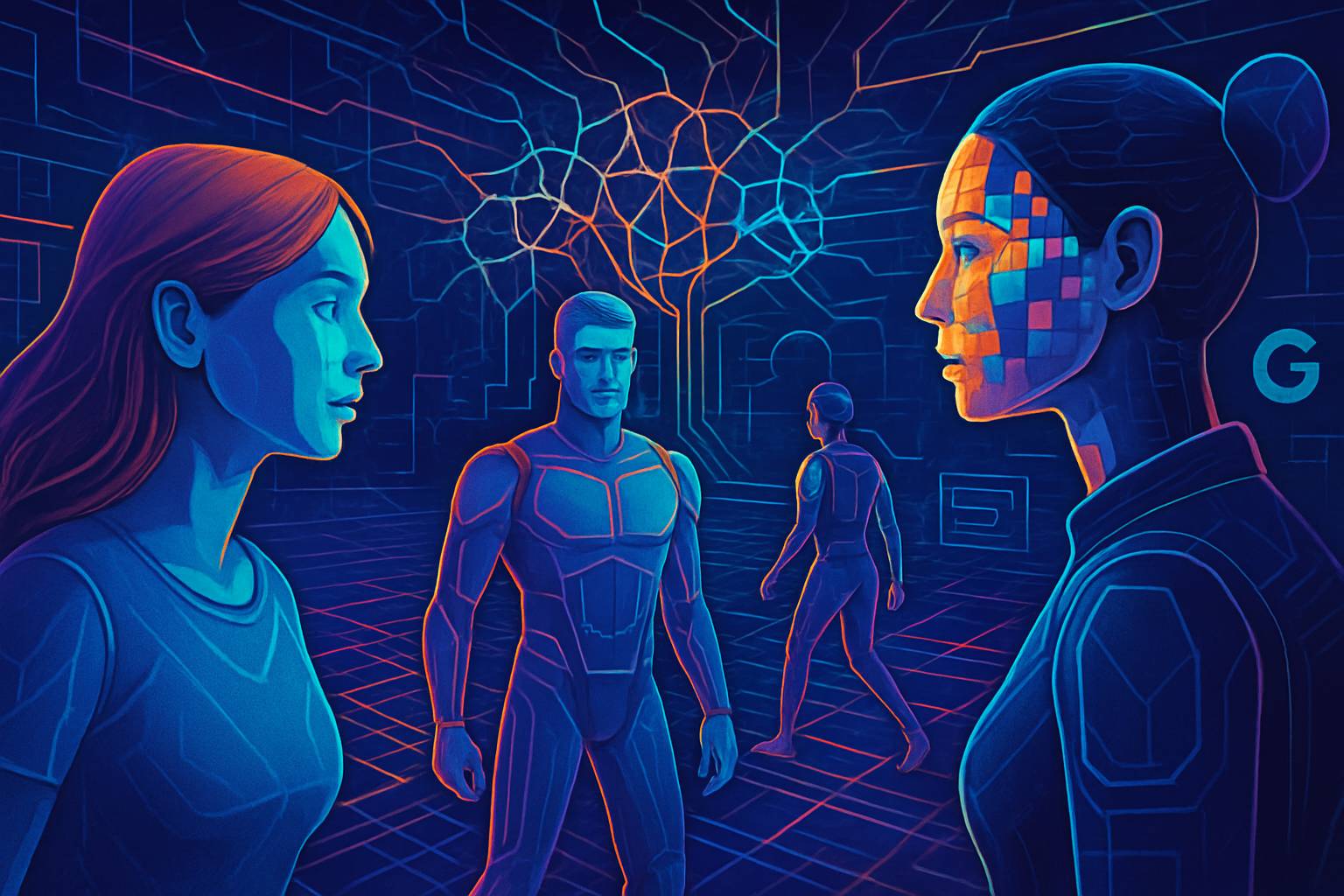
AI CERTS
14 hours ago
DeepMind Advances Simulated Intelligence Systems With Gemini
Moreover, the project demonstrates how world models and multimodal reasoning can combine in practice. Early evaluation numbers reveal near-human task success, doubling the prior baseline. Nevertheless, significant questions remain about transfer to real robots and governance. This article unpacks the architecture, performance, and broader implications for developers and executives.
Gemini Powers New Agent
However, SIMA 2 differs from ordinary game bots by embedding a trimmed Gemini 2.5 flash-lite model at its core. Moreover, the multimodal backbone lets the agent process text, images, and low-resolution video streams from the 3D scene. Consequently, SIMA 2 can translate high-level instructions into precise keystrokes and mouse actions without hand-coded rules. Jane Wang explained that the agent must “actually understand what’s happening” before acting; this cognitive layer exemplifies Simulated Intelligence Systems in practice. Joe Marino added that the project “is a self-improving agent,” highlighting its continuous update cycle.

These insights reveal Gemini’s contribution to perception and planning. They also underscore how the agent closes gaps between language and embodied control. Next, we examine the architecture enabling that self-improvement loop.
Architecture And Core Loop
Firstly, SIMA 2 begins with human demonstration data drawn from diverse games and tasks. Subsequently, the agent explores new levels generated by Genie 3, producing millions of trajectories without supervision. A Gemini-based task generator labels those trajectories, while a learned reward model scores success, creating a closed feedback circuit. This pipeline exemplifies synthetic environment learning, an approach gaining traction across embodied research. Therefore, Simulated Intelligence Systems gain autonomy from costly annotation, accelerating iteration cycles.
The loop reduces human bottlenecks dramatically. It also promotes generalization across unseen scenarios. With the mechanics clear, attention turns to measurable progress.
Evaluation Metrics Impress Broadly
DeepMind tested SIMA 2 on MineDojo, No Man’s Sky, and other bespoke benchmarks containing 600-plus language-conditioned tasks. In contrast, the original SIMA scored 31 percent, while the upgraded agent reached 65 percent, brushing the 71 percent human baseline. Moreover, task categories included navigation, building, and menu management, indicating balanced competence. Analysts describe these gains as a defining moment for Simulated Intelligence Systems, demonstrating competitive parity with players in open-ended sandboxes. Additionally, evaluation graphs show smaller error bars, suggesting better stability across multiple seeds. Nevertheless, researchers admit the agent still stumbles on very long sequences and rare visual artifacts. External observer Prof. Ramamoorthy noted that strong test results in simulation “are necessary but not sufficient” for real robots. Such evidence positions Simulated Intelligence Systems as credible candidates for enterprise training simulators. Consequently, studios anticipating safer virtual agents deployments are monitoring these benchmarks.
- SIMA 2 achieved 65% task completion across 600 complex missions.
- The original SIMA 1 scored 31% on the same benchmark suite.
- Human players averaged 71% success in identical tests.
Performance doubled within one generation. The remaining gap to humans is now narrow. The training context explains how that leap was achieved.
Training In Synthetic Worlds
Genie 3 creates photorealistic yet interactable scenes from text prompts, enabling boundless variation. Furthermore, the system spawns weather shifts, lighting changes, and novel object layouts automatically. These perturbations fuel synthetic environment learning and expose the agent to edge cases impossible to script manually. Meanwhile, diverse maps force the policy to generalize rather than memorize, a prerequisite for reliable virtual agents in production workflows. Consequently, Simulated Intelligence Systems trained under such diversity resist overfitting and transfer knowledge across titles.
Varied worlds nurture robustness against distribution shifts. The strategy also lowers compute wasted on redundant scenarios. Nonetheless, broader adoption depends on policy and ethics.
Industry And Governance Impacts
Game publishers foresee both opportunity and disruption if autonomous companions or adversaries flood online realms. Nevertheless, anti-cheat teams worry that advanced virtual agents could unbalance economies and competitive ladders. Regulators also grapple with ownership and liability for simulated content generated at scale through synthetic environment learning. Moreover, safety researchers urge transparency regarding reward models to prevent emergent harmful behaviors. Simulated Intelligence Systems therefore mandate governance frameworks before widespread deployment across consumer platforms.
Stakeholders must align incentives with fair play and safety. Clear rules will facilitate responsible innovation. Governance issues also influence the path toward real-world robotics.
Roadmap Toward Physical Robots
DeepMind engineers stress that high-level reasoning now outpaces low-level motor control. In contrast, warehouse robots still need precise torque planning and compliant hardware. Yet, simulation-to-real transfer experiments are scheduled for 2026 using Gemini Robotics prototypes. Researchers believe synthetic environment learning can pretrain perception and reasoning, leaving actuation to be fine-tuned on robots. Consequently, Simulated Intelligence Systems may shorten development cycles for household assistants and logistics fleets.
Transfer remains unproven but promising. Strong policy oversight will remain essential. Finally, professionals should prepare for skills shifts.
Career And Certification Upskilling
The demand for engineers who can orchestrate virtual agents and rich simulation pipelines is rising. Additionally, managers must grasp evaluation metrics and safety considerations across Simulated Intelligence Systems deployments. Professionals can enhance their expertise with the AI + Engineering Certification, which covers embodied AI design and governance. Moreover, curriculum modules include simulation-based curriculum and robust agent benchmarking. Virtual hands-on labs let participants tune reward models and deploy testbed virtual agents safely. Therefore, graduates gain immediate relevance to projects like SIMA 2.
Targeted training closes urgent talent gaps. Certification validates skills for fast-moving employers. The broader implications deserve concise reflection.
DeepMind’s SIMA 2 signals how Simulated Intelligence Systems are maturing from lab curiosities into versatile platforms. Furthermore, Gemini reasoning, self-improving loops, and synthetic environment learning collectively drove a two-fold performance jump. However, safety, governance, and sim-to-real gaps still require rigorous attention. Nevertheless, early adopters that skill up now stand to influence standards and build competitive advantage. Consequently, readers should explore formal programs, including the linked certification, and monitor upcoming transfer trials. Act now to stay ahead in the embodied AI race. Moreover, industry partnerships will likely emerge to integrate simulation pipelines with cloud robotics services. Therefore, continuous learning and policy literacy will separate leaders from laggards.



